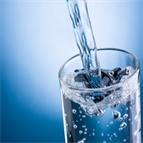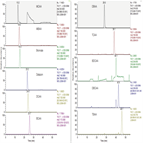Find methods for your needs
Refine by Feature
Displaying 1-5 of 7 results for Tag: Haloacetic acid
Quantitative Determination of Disinfection Byproduct Haloacetic Acids in Drinking Water using a New Mixed-Mode column and Liquid Chromatography Tandem MS Haloacetic Acids
Instrument Type: LCMSMSHaloacetic acids (HAAs) occur in drinking water during the disinfection process and have been regulated by the US EPA as HAA5. Haloacetic acids have been linked to potential threats to human health thus monitoring of their presence is of critical importance to public health. We describe a sensitive LC-MS/MS method for direct analysis of three regulated chlorinated HAAs at trace level in drinking water without sample derivatization, concentration, or ion paring agents. the mixed mode column was developed specifically for the regulated HAA's in Japan.
EPA Method 557 - Analysis of Haloacetic Acids, Dalapon, and Bromate in Drinking Water by IC-MS/MS
Instrument Type: ICMSHaloacetic acids (HAAs) are formed as disinfection byproducts when water is chlorinated to kill bacteria. Chlorine reacts with naturally occurring organic and inorganic matter in the water, such as decaying vegetation, to produce disinfection by-products (DBPs) that include HAAs. Of the nine species of HAAs, five are currently regulated by the U.S. Environmental Protection Agency (EPA). We demonstrate a simple and sensitive IC-MS/MS method for analyzing haloacetic acids, the pesticide dalapon, and bromate in water using EPA Method 557.
Quantification of Haloacetic Acids in Tap Water Using a Dedicated HAA LC Column with LC-MS/MS Detection
Instrument Type: LCMSMSIn April 2012, methods provided by the Japanese Ministry of Health, Welfare and Labour based on provisions in the Water Quality Standards Ordinance (Ministry of Health, Welfare and Labour, Notification 261, July 2003) were revised, and the inspection method for haloacetic acids (HAAs) was expanded to include an analysis method using liquid chromatography paired with mass spectrometry (LC/MS or LC-MS/MS) as an alternative to gas chromatography with mass spectrometry (GC/MS). We describe an LC-MS/MS method for measuring haloacetic acids in tap water using a dedicated HPLC column.
AN630: EPA Method 557 – Analysis of Haloacetic Acids, Dalapon, and Bromate in Drinking Water by IC-MS/MS: HAA9
Instrument Type: ICMSHaloacetic acids (HAAs) are formed as disinfection byproducts when municipal chlorination processes react with naturally occurring brominated and chlorinated species. Five HAAs are currently regulated, whereas four others may be included in future regulations. Here we demonstrate the determinations of 0.02 to 0.1 ng/L (ppt) HAA9 concentrations using ion chromatography separations combined with tandem MS on a triple quadrupole mass spectrometry.
AN43227: Speciation of Bromine Compounds in Ozonated Drinking Water using Ion Chromatography and Inductively Coupled Plasma Mass Spectrometry
Instrument Type: ICBromate and brominated organic acids are generated by ozonation of bromide in municipal disinfection processes. The brominated compounds are toxic so compliance monitoring is required. Here four bromine species, including bromate are determined in drinking water using IC coupled to ICP-MS according to a modified U.S. EPA Method 321.8. The ions are separated by IC using a KOH gradient on an IonPac AS19 column. Then the eluting species are detected and quantified by ICP-MS down to ng/L concentrations with negligible spectral interferences using Kinetic Energy Discrimination (KED).





